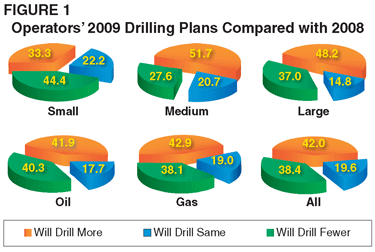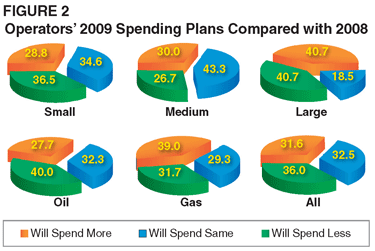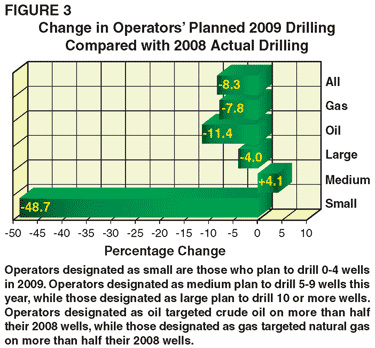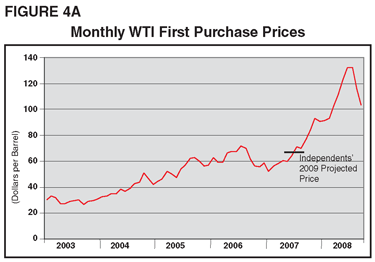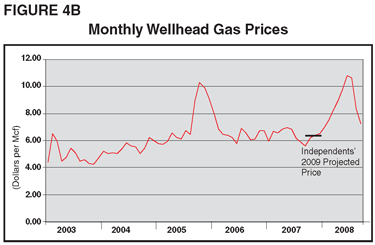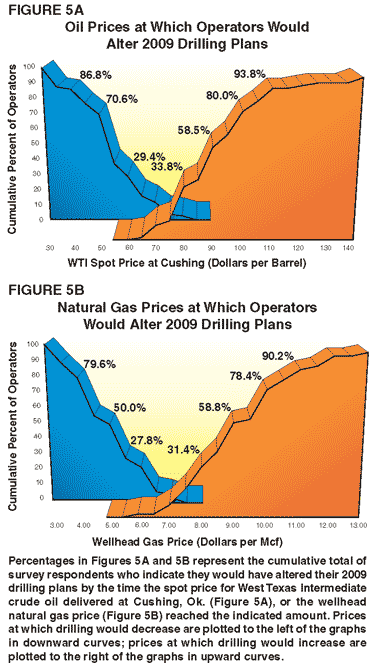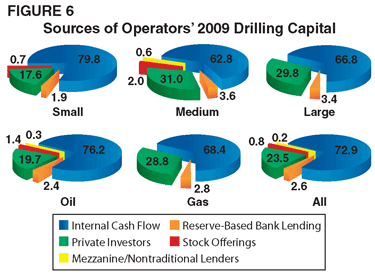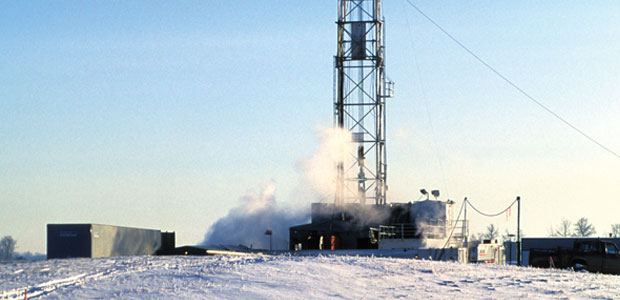
U.S. Independents Drill Their Way Into A Shadowy Future
By Bill Campbell
The refrain from an old Irish ballad goes in part, “’Tis I (who will) be there, in sunshine
or in shadow . . .”
Certainly the U.S. exploration, drilling and production industry has enjoyed the sunshine over the past several years. According to U.S. Energy Information Administration numbers, the average drilling-rig count climbed from 830 in 2002 to 1,883 for the first 10 months of 2008. Well completions, meanwhile, rose from 27,655 in 2002 to 45,137 for the first 10 months of 2008, which if the pace continued through November and December, would have put domestic oil and gas producers over the 50,000-well mark for the first time since 1985.
2009, however, may be a year for some shadow.
Faced with a near free fall in crude oil and natural gas prices over the latter half of 2008, respondents to The American Oil & Gas Reporter’s 2009 Survey of Independent Operators projected they would back off their pace of 2008 drilling by 8.3 percent in 2009.
Despite that uncharacteristic downward projection for total drilling, survey respondents nevertheless left no doubt that U.S. independents would still “be there” in 2009. A plurality of survey respondents (42.0 percent) still say they expect to drill more wells this year than last year (Figure 1), while another 19.6 percent say they will drill the same, meaning three of five respondents expect to drill as many or more wells in 2009 as they did in 2008.
Spending forecasts are even more upbeat, with 64.1 percent indicating they will spend as much or more drilling wells this year as they did last year (Figure 2). Gas-well drillers (those that indicated they targeted natural gas with more than half their 2008 wells) are more positive than are oil-well drillers (respondents that indicated they targeted crude oil with more than half their 2008 wells). Among gas-well drillers, 68.3 percent say they expect to spend as much or more in 2009 as they did in 2008, compared with 60.0 percent of oil-well drillers.
When it comes to operator size, the medium category of respondents (those that project drilling five to nine wells in 2009) have the most optimistic spending plans, with 73.3 percent saying they will spend as much or more this year. The medium category of survey respondent was the only one to project an increase in total drilling for 2009, coming in at a plus 4.1 percent (Figure 3).
The spending outlook for the small category of survey respondents (zero to four wells in 2009) shows 63.4 percent anticipate spending as much or more this year, while 59.2 percent of the large category of respondents (those that plan to drill 10 or more wells in 2009) say they will spend as much or more.
The American Oil & Gas Reporter mails the Survey of Independent Operators annually in November to oil and gas producers nationwide, selected randomly from the magazine’s circulation list. No attempt is made to identify survey respondents, and The Reporter’s staff compiles and analyzes the data. The Survey of Independent Operators does not account for dry holes, and merely asks operators what the intended target is when a well is spudded.
2009 Drilling Activity
Gas-well drillers are more optimistic than oil-well drillers when it comes to the number of survey respondents that say they will drill more wells this year. A little more than two in five respondents (42.9 percent) in the gas-driller category say they will drill more wells this year than they did last year, while 19.0 percent say they will drill the same. This compares with 41.9 percent of oil-driller category respondents, who say they will drill more wells this year and 17.7 percent who say they will drill the same number.
By size, 51.7 percent of the medium category of survey respondents say they will drill more wells, with 20.7 percent indicating plans to drill the same, followed by 48.2 percent of large-category respondents who say they will drill more and 14.8 percent intending to drill the same. Only 33.3 percent of the small category of respondents say they will drill more wells in 2009, while 22.2 percent are planning to keep activity level.
Those relationships persist through survey respondents’ projections for total 2009 drilling activity (Figure 3). There, the small category of respondents anticipates taking the biggest hit, projecting total wells drilled will be down 48.7 percent. However, it should be noted that because of the small number of wells drilled by respondents in this category–an average of 3.5 in 2008, which drops to 1.8 in 2009–any shift in well numbers causes a large percentage change.
More reflective of the whole, the large category of survey respondents says it expects the final 2009 well count to dip 4.0 percent, while the medium category actually projects an increase of 4.1 percent in 2009 drilling. Between the oil- and gas-categories of respondents, oil-well drillers foresee tougher times ahead, projecting a decline of 11.4 percent, compared with a minus 7.8 percent for gas-well drillers.
Price Response
The caveat, of course–and the big question going forward–is at what price all these drilling projections actually materialize.
In November 2007, when the light-sweet crude oil contract on the New York Mercantile Exchange was flirting with $100 a barrel and posted prices in much of the nation were north of $80, respondents to the 2008 Survey of Independent Operators said they were basing their 2008 drilling plans on an oil price of $66.62 a barrel (The Reporter, January 2008, pg. 46).
The 2009 Survey of Independent Operators was mailed Nov. 8, 2008, with a deadline for returns of Nov. 21. During that period, crude oil prices (West Texas Intermediate spot at Cushing, Ok.) dropped from $62.16 a barrel on Nov. 10 to $49.17. Nevertheless, 2009 survey respondents say this year’s drilling plans are based on expectations of oil selling for $69.82 a barrel, only a few dollars away from the 2008 price deck.
To put that in perspective, the last time the monthly WTI first-purchase price averaged less than that, according to EIA, was June 2007 when WTI sold for an average of $63.83 a barrel, on its way to $71.42 a barrel in July 2007 and $70.25 a barrel in August (Figure 4A).
The small category of survey respondents express the most hopeful outlook for oil prices, projecting $72.84 a barrel for their 2009 drilling plans, followed by the medium category of respondents at $68.91 and the large category at $67.22. Oil-well drillers project a 2009 crude oil price of $70.42 a barrel, while gas-well drillers anticipate a more modest $66.25 a barrel.
A year ago, 2008 survey respondents indicated they expected to receive $6.28 an Mcf for their natural gas production during a survey period when spot prices (Henry Hub) ranged between $7.36 and $6.66 an MMBtu. During the period operators were responding to the 2009 Survey of Independent Operators, gas prices ranged between $7.06 and $6.32 an MMBtu, and they pegged $6.43 an Mcf as the price on which their 2009 drilling plans were based.
That number compares with EIA’s average wellhead price reported for the latter months of 2007 (Figure 4B), when gas was recovering from a low of $5.61 an Mcf in September 2007 on its way to its June 2008 peak of $10.82.
Again, the small category of survey respondents requires the highest price, anticipating $6.48 an Mcf this year, followed by the large category at $6.52 and medium-category respondents at $6.11. Oil-well drillers say they expect gas to fetch $6.43 an Mcf in 2009, while gas-well drillers peg $6.38 an Mcf.
A $10 move in oil prices off respondents’ projected baseline is enough to either get more rigs running or return them to their yards. At $80 a barrel for crude oil (Figure 5A), 33.8 percent of survey respondents indicate they will increase their 2009 drilling plans. More than half (58.5 percent) say they will drill more wells this year if oil rises to $90 a barrel, and at $100, 80.0 percent of respondents say they will drill more wells.
On the flip side, at $60 a barrel for crude oil, 29.4 percent of survey respondents say they will reduce the number of wells they anticipate drilling this year, while 70.6 percent say they will cut back at $50 oil and 86.8 percent will drill fewer wells at $40 a barrel.
For natural gas, a downward price movement would elicit a quicker response than would rising prices. At $5.50 an Mcf for gas (Figure 5B), 27.8 percent of survey respondents say they will drill fewer wells this year, while an even 50.0 percent say they will cut back at $5.00 an Mcf. If prices fall to $4.50 an Mcf, 55.6 percent of survey respondents indicate they will reduce their 2009 drilling plans, while 79.6 percent say they will re-evaluate at $4.00 an Mcf.
Going the other way, it is not until gas prices reach $8.00 an Mcf that 31.4 percent of survey respondents say they will increase their 2009 drilling plans. At $9.00 an Mcf, 58.8 percent say they will drill more wells, and 78.4 percent will do so at $10.00 an Mcf.
Drilling Capital
Commodity prices translate to cash flow, and that is where nearly three-fourths of the money used by U.S. independents to drill wells will come from, with most of the rest supplied by private investors, according to the 2009 Survey of Independent Operators.
Survey respondents indicate internal cash flow will fund 72.9 percent of their 2009 drilling budgets (Figure 6). Another 23.5 percent comes from private investors, according to survey respondents, while reserve-based lending provides 2.6 percent, and stock offerings along with mezzanine and nontraditional lenders account for the remaining 1.0 percent.
The small category of survey respondents is most dependent on cash flow, indicating 79.8 percent of its drilling capital comes from that source. The large category of respondents is next, with 66.8 percent of drilling funds coming from cash flow, while the medium category generates 62.8 percent of its drilling capital internally. Oil-well drillers get a larger proportion of their drilling funds from internal cash flow than do gas-well drillers by a 76.2-68.4 percent margin.
No survey respondents expect to find money growing on trees during 2009. Asked how they anticipated investor/capital market confidence in oil and gas drilling programs would affect their ability to raise drilling capital, 54.8 percent of respondents indicate they expect it to be more difficult to raise funds, while 43.3 percent expect no change.
The small category of survey respondents expects to have the most trouble raising money, with 65.2 percent saying it will be harder to secure funds. It is followed by the large category of respondents, of which 56.0 percent expect to have more trouble raising funds, while 46.4 percent of medium-category respondents expect to have more trouble obtaining financing.
Among oil-well drillers, 53.4 percent say they expect it to be more difficult to raise drilling capital, compared with 51.3 percent for gas-well drillers.
The proportion of survey respondents who hedge at least some of their production continues to grow, with 35.1 percent saying they hedge some portion of their oil and gas sales, compared with 32.0 percent in 2008 and 33.0 percent in 2007.
Among those who say they hedge some portion of their production, 39.9 say they hedge 1-25 percent, 22.8 percent hedge 26-50 percent, 17.7 percent hedge 51-75 percent, and 19.7 percent hedge 76-100 percent.
As in prior surveys, large-category and gas-well drillers are the most likely to hedge. Among the large category of respondents, 57.1 percent say they hedge some portion of their production, and 50.1 percent of those who do so say they hedge more than half their production.
In the medium category of survey respondents, 27.6 percent say they do some hedging, while 26.9 percent of small-category respondents hedge.
Among gas-well drillers, 48.8 percent say they hedge, with 47.7 percent of those protecting more than half of their sales and 76.4 percent hedging at least 25 percent. About one-fourth (25.4 percent) of oil-well drillers say they hedge a portion of their production.
Respondent Profile
The “average” respondent to the 2009 Survey of Independent Operators drilled 14.7 wells in 2008 and expects to drill 13.5 wells in 2009. Other than the number of wells, however, survey respondents in total indicate their 2009 drilling programs pretty much will mirror what they did in 2008.
All survey respondents targeted natural gas with 69.1 percent of their wells in 2008, and say they will be drilling for gas 70.6 percent of the time in 2009. Exploratory wells accounted for 10.4 percent of respondents’ 2008 drilling and will be 11.5 percent of 2009 wells. Average drilling depth goes from 6,301 feet last year to 6,308 feet this year.
The four significant shifts in drilling programs occur in the oil-to-gas ratio among small-category respondents, amount of anticipated wildcatting among medium-category respondents, and well depth for both small- and medium-category respondents. The small category of respondents targeted natural gas with 22.9 percent of their 2008 wells, but say they will look for gas with 40.2 percent of their 2009 wells. Medium-category respondents were exploring with 15.7 percent of their 2008 wells, but will be wildcatting 23.0 percent of the time in 2009. And both small- and medium-category respondents indicate they will be drilling deeper this year, with average well depths going from 3,654 feet to 4,662 feet for the small category and from 4,180 feet to 5,187 feet for the medium category.
Large-category drillers tend to be much more oriented to natural gas than either the small or medium category. Large-category drillers say they were looking for natural gas with 81.9 percent of their wells last year, and will do so on 79.6 percent of their 2009 wells. That compares with small-category respondents who were 77.1 percent oil and 22.9 percent gas in 2008, and will go to 59.8 percent oil and 40.2 percent gas in 2009; and medium-category respondents, who were 55.6 percent oil and 44.4 percent gas in 2008, and will go to 58.1 percent oil and 41.9 percent gas in 2009.
Oil-well drillers are much more likely to be drilling exploratory wells than are gas-well drillers. Oil-well drillers say 20.4 percent of their 2008 wells were wildcats, and 21.0 percent of their 2009 wells will be wildcats. Gas-well drillers were wildcatting on only 8.4 percent of their 2008 wells, and say 9.6 percent of their 2009 wells will be exploratory.
Gas-well drillers are going considerably deeper than oil-well drillers. Average depths reported by gas-well drillers were 7,170 feet in 2008, which drops to 6,978 feet in 2009. This compares with an average of 3,912 feet on 2008 wells for oil-well drillers, who say their 2009 wells will average 4,406 feet.
For other great articles about exploration, drilling, completions and production, subscribe to The American Oil & Gas Reporter and bookmark www.aogr.com.







